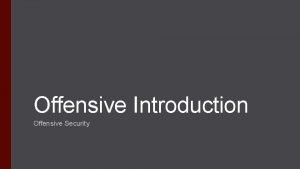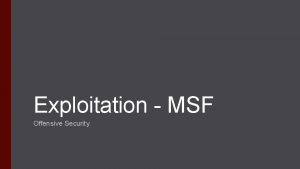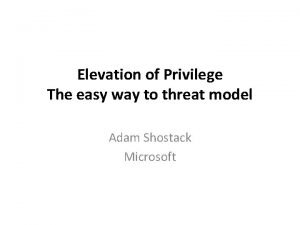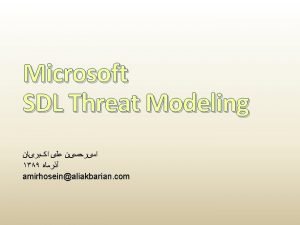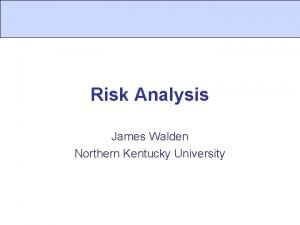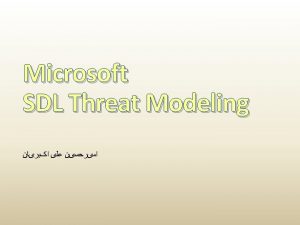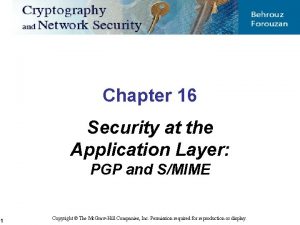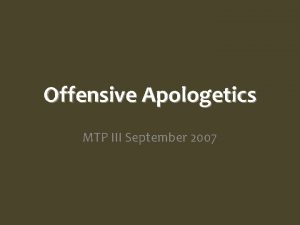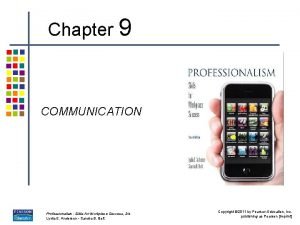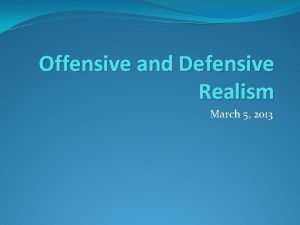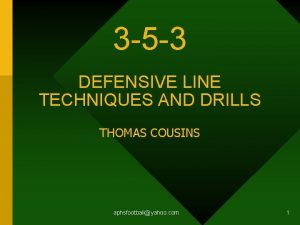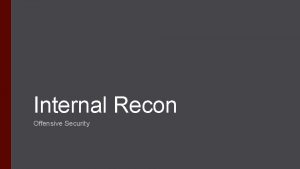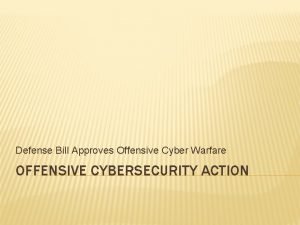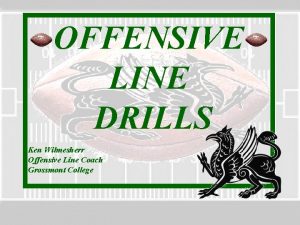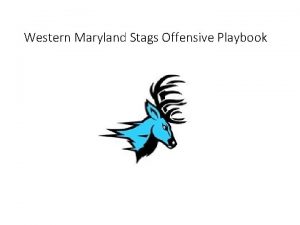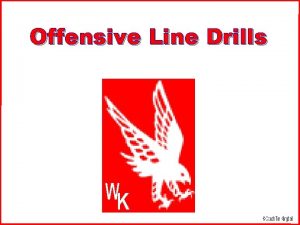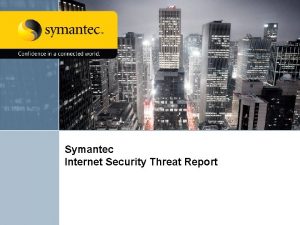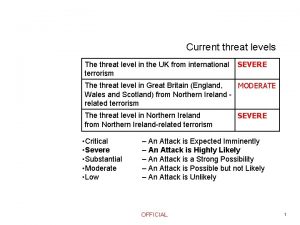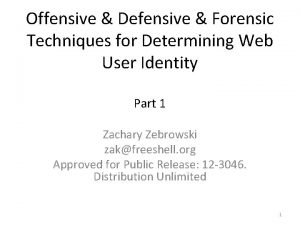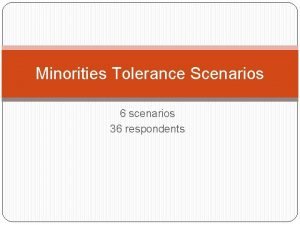Threat Modeling Offensive Security Determining threat scenarios that































- Slides: 31

Threat Modeling Offensive Security

• Determining threat scenarios that can lead to compromise of a system • Understanding the system • Thinking like an attacker • Devising a way in Offensive Security What is threat modeling? 2

• Helps confirm to-be-implemented security features • Helps identify security gaps • Helps identify monitoring shortfalls and requirements • Helps identify vulnerabilities in the system • Helps identify additional test cases to verify the security of the system Offensive Security Threat Modeling – Why? 3

• Gather relevant data • Identify and categorize primary and secondary assets • Identify and categorize threats and threat communities • Map threats to assets Offensive Security PTES Threat Modeling 4

Gathering relevant data • Everything about the business Organizational structure Processes Sensitive information Product details Services rendered Documentation on the business OSINT sources From the customer Offensive Security • 5

• Policies Plans Procedures • Intellectual Property, Trade secrets, R&D • Customer & employee data • Marketing information • Financial information Offensive Security Assets 6

Offensive Security What would DSU consider assets? 7

What is a ”threat”? • Potential danger • Malicious intent • Accidental • There doesn’t need to be a vulnerability for there to be a threat Offensive Security Natural disaster 8

Motivation • Why would someone target YOU? • Profit • Hacktivism • Political • Competitor • Rep? ? ? Offensive Security As an organization 9

Offensive Security What threats does DSU face? Motivation? 10

NIST SP 800 -30 R 1 Guide for Conducting Risk Assessment Frame risk Provide context to how risk is assessed, monitored, and responded to Assess risk Identify threats, vulnerabilities, harm, and likelihood Respond to risk Develop a course of action, evaluate, and implement response Monitor risk Determine effectiveness of response, identify changes, verify responses are implemented Offensive Security • 11

Threat • Event with the potential to negatively impact an organization Denial of Service Disclosure of information Unauthorized access Modification of information Threats are carried out by a threat actor Insider threat Nation State Script Kiddie Hactivist group Offensive Security • 12

• Weakness in a system • Can be exploited by a threat source • Software issues • Misconfigurations • Failover weaknesses • etc Offensive Security Vulnerabilities 13

Likelihood • What are the chances of the threat + vulnerability happening • Intent Does exploiting this vulnerability meet the goals of the threat actor? • Capability • Targeting Does your organization have something the threat actor wants? Offensive Security Does the threat actor have the means to exploit the vulnerability? 14

Impact • The extent of the harm caused • How will it impact… The business services Reputation Data Financials Think about the range and number of resources affected Offensive Security • 15

Offensive Security Risk Assessment Model 16

Assess Risk • Example of a risk? _____ • What is an associated vulnerability? _____ • What harm could be caused by the risk + vulnerability? Impact level? • What is the likelihood of this occurring? _____ Offensive Security _____ 17

Assess Risk • Example of a risk actor? Hactivist group • What is an associated vulnerability? Known vulnerability in apache • What harm could be caused by the risk + vulnerability? • What is the likelihood of this occurring? Likely – known vulnerability in publicly facing server Offensive Security Defaced website + decreasing reputation Medium Impact 18

poll. dakotastate. net • Rate the risk of the following: Unpatched Eternal. Blue vulnerability in an internal windows file server that contains proprietary product information • A. Low Likelihood, High Impact • B. Medium Likelihood, High Impact • C. High Likelihood, Low Impact • D. Medium Likelihood, Medium Impact • E. None of the above Offensive Security Poll 19

Do. D Cyber Table Top Scalable threat modeling to a given system Offensive Security • 20

• Helps to better identify risks in a system or system of systems • Educates non-technical engineers, system owners, managers etc • Builds a more secure product or organization Offensive Security Cyber Table Top 21

Scoping • Still challenging Time is always the issue Cyber table top is flexible System of systems Better yet… both Risk to organization all the way down to risk to a login process on a given system Offensive Security • 22

• OPFOR == Opposing Force • Develops attacks • Achieve missions based on kill chain • Can use known CVE, CWE, CAPEC’s • Emulates attacker based on TTP’s (Tools, Techniques, Procedures) Script kiddie – Nation state Is it a common tool in Kali, or difficult to custom develop Offensive Security OPFOR 23

Operations Team • Blue teams Defenders • System admins, engineers Builders, maintainers System users Regular users of a system Offensive Security • 24

Do. D Cyber Table Top Scalable threat modeling to a given system Offensive Security • 25

Offensive Security Simplified Kill Chain 26

Model the system • Identify trust boundaries • Add actors, both internal and external • Note information flow especially between boundaries • Locate key assets in the network • Add impact value Offensive Security Firewalls are key Separation of internet vs. secure servers network Security zones within the internal network 27

• Identify boundaries • Note information flow • Identify key assets • Where would impact be high? Low? Offensive Security Example Network 28

• Attack: Access • Attack Description: Malicious user will attempt to gain access to the network by sending phishing emails to users on the network. This will most likely result in low level user access to a domain connected system. In rare circumstances a privileged user may be compromised. • Assumption: Users will click on a phish. Offensive Security Example: Attack 1 29

• Attack cost and effort: Low, finding email addresses for a given organization is not challenging. Creating a phishing email is not difficult. • Likelihood: [Use scale of 1 -5 with description] 5, High likelihood of a phish being clicked on by a user. • Result: User level access to the system • [IF ATTACK IS EFFECT OR EXFILTRATE] Impact: (How does this impact the organization in short and long term? Offensive Security Example: Attack 1 30

Other Ideas • Supply chain Compromised hardware • Physical access • USB Droppers • Wi-Fi • Web applications • VPN applications • Core business functions • Users Which service they are the administrator of • Cyber-attack causing kinetic effects Offensive Security Peripherals (keyboards, mice) 31
 Intro to offensive security
Intro to offensive security Offensive security metasploit tutorial
Offensive security metasploit tutorial Helen erickson nursing theory
Helen erickson nursing theory Relational modeling vs dimensional modeling
Relational modeling vs dimensional modeling Private security
Private security David adjey
David adjey Threat modelling web application
Threat modelling web application Sdl model
Sdl model Microsoft threat modeling tool
Microsoft threat modeling tool Threat modeling
Threat modeling Sdl model
Sdl model Gây tê cơ vuông thắt lưng
Gây tê cơ vuông thắt lưng Phân độ lown ngoại tâm thu
Phân độ lown ngoại tâm thu Tìm vết của đường thẳng
Tìm vết của đường thẳng Sau thất bại ở hồ điển triệt
Sau thất bại ở hồ điển triệt Block nhĩ thất độ 2 mobitz 2
Block nhĩ thất độ 2 mobitz 2 Hãy nói thật ít để làm được nhiều
Hãy nói thật ít để làm được nhiều Thể thơ truyền thống
Thể thơ truyền thống Tôn thất thuyết là ai
Tôn thất thuyết là ai Walmart thất bại ở nhật
Walmart thất bại ở nhật Thơ thất ngôn tứ tuyệt đường luật
Thơ thất ngôn tứ tuyệt đường luật Explain pgp scenarios for application layer security
Explain pgp scenarios for application layer security Offensive apologetics
Offensive apologetics Offensive language in the workplace
Offensive language in the workplace Being zealous without being offensive means---
Being zealous without being offensive means--- What is defensive realism
What is defensive realism Penguin elbow name
Penguin elbow name Parallel structure means using the same pattern of
Parallel structure means using the same pattern of Meuse argonne offensive apush
Meuse argonne offensive apush The tet offensive
The tet offensive Defensive line get off drills
Defensive line get off drills The least offensive play in the whole darn world
The least offensive play in the whole darn world
